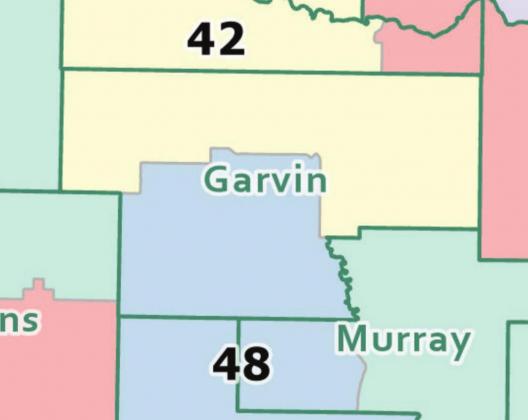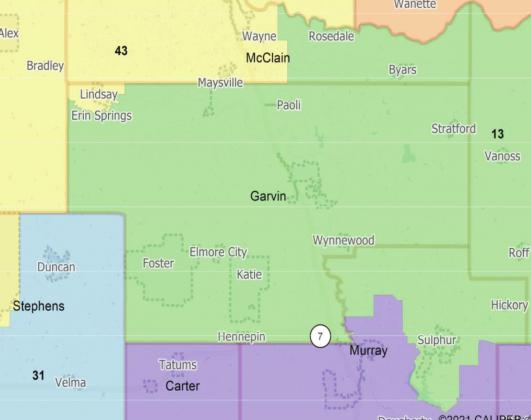Proposed redistricting maps released Monday show some of Garvin County’s legislative districts will likely see significant changes as state legislators work to navigate new data that includes an unexpected population shift from rural to urban areas.
The Legislature voted to approve redistricting maps before the end of the legislative session in May. However, because of COVID-19 related delays in U.S. Census data, those maps were based on 2019 population data – the best estimates available at the time.
Final U.S. Census data released in September found Oklahoma's population grew by 5.5% to 3.96 million, with the greatest percentage of growth in urban areas.
“That shift from rural to urban was more significant than expected,” Rep. Ryan Martinez of Edmond said during Monday’s press conference to present new maps. Martinez serves as chair of the House redistricting committee.
Compared to the plan passed in May, the House proposal released Monday generally shifts western districts somewhat further toward the Oklahoma City area, and eastern districts somewhat further toward the Tulsa area. It is more compact than the prior plan, with each of the 101 House districts having a target population of 39,202, and it keeps 80% of Oklahomans in the same House district they are in today.
"While changes had to be made to most House districts to meet population requirements, those changes were minor," Martinez said. "Given the bipartisan, statewide popularity of the prior plan, this plan is also expected to be well-received in the House."
The biggest shift locally will be in the number of Oklahoma House districts covering the county. Currently, Garvin County has four districts that serve different parts of the county. Under the new proposal, the county will be split between two districts: House District 42, represented by Cynthia Roe, R-Lindsay, and House District 48, represented by Tammy Townley, R-Ardmore.
Those changes were also reflected on the maps approved in May, but the new proposal released this week shifts the boundaries of both districts further north, moving Elmore City and portions of Pauls Valley from House District 42 to House District 48.
The Senate map also experienced minor changes under final Census data. Each of the 48 Senate districts has a target population of 82,487.
"Overall, the proposed Senate maps are very similar to the maps that were approved nearly unanimously in May. Changes to the proposed Senate maps were minimal, and yet the map remains more compact than the existing maps," Sen. Lonnie Paxton of Tuttle and chair of the Senate redistricting committee, said Monday.
For Garvin County, Senate district changes will be minimal with Senate District 13, currently served by Senator Greg McCortney, R-Ada, extending further west, covering most of the county. The northwestern corner of Garvin County, including Lindsay, will remain part of Senate District 43, represented by Senator Jessica Garvin, R-Duncan.
Legislators also released proposed Congressional District maps on Monday.
To evenly divide the state’s population, proposed Congressional Districts 1, 2 and 3 each have populations of 791,871 each and proposed Congressional Districts 4 and 5 each have populations of 791,870.
In the Oklahoma City area, proposed Congressional District 5 continues to receive the majority of its population from within the Oklahoma City city limits, while adding fast-growing suburban communities in Canadian, Logan and Lincoln counties that, based on public input, commuter and economic patterns, are considered key parts of the Oklahoma City metropolitan area.
In the Tulsa area, CD-1 would become more compact by shedding Washington County and half of Wagoner County while adding Sapulpa in Creek County.
The rural areas of the state would continue to be divided into three districts largely similar to the current compositions of CDs 2, 3 and 4.
Oklahoma’s Congressional District 4, represented by Tom Cole, remains unchanged covering much of the southwestern portion of the state, including Garvin County.
Based on its population in the 2020 U.S. Census, Oklahoma maintains its five congressional seats.
Statewide, the new proposals make legislative and congressional districts more compact, keep 87% of Oklahomans in the same congressional district and leave major military bases and related military communities in the same congressional districts.
"Oklahoma ran a clean, nonpartisan, public-focused process," Martinez said. "On behalf of the House, my thanks go to all those who engaged and worked on these districts – especially the citizens. I believe Oklahoma should be extremely proud of both the process and the proposal."
The Oklahoma Constitution requires legislative and con gressional districts to be redrawn by the Legislature every ten years.
"Our commitment from the beginning was to conduct an open and transparent redistricting process, and we kept that commitment," Paxton said. "I am proud of the work of my colleagues in the Legislature throughout redistricting, the fine work of our redistricting staff, and the public’s participation and engagement."
The proposals will be voted on in a legislative special session beginning Nov. 15. Like any legislative bill, the proposals will receive committee and floor votes. They must pass both legislative chambers and be signed by the governor to become law.


